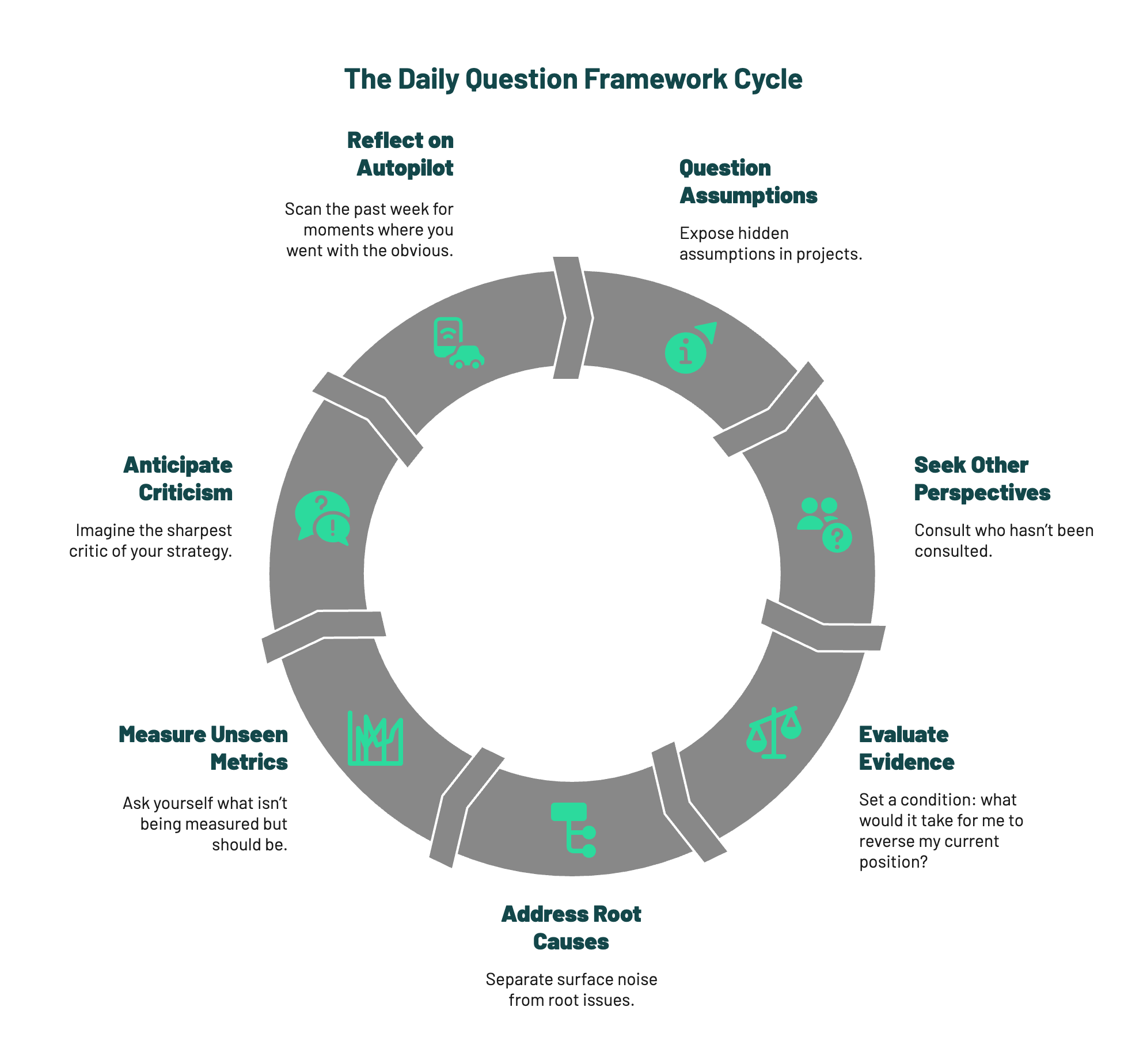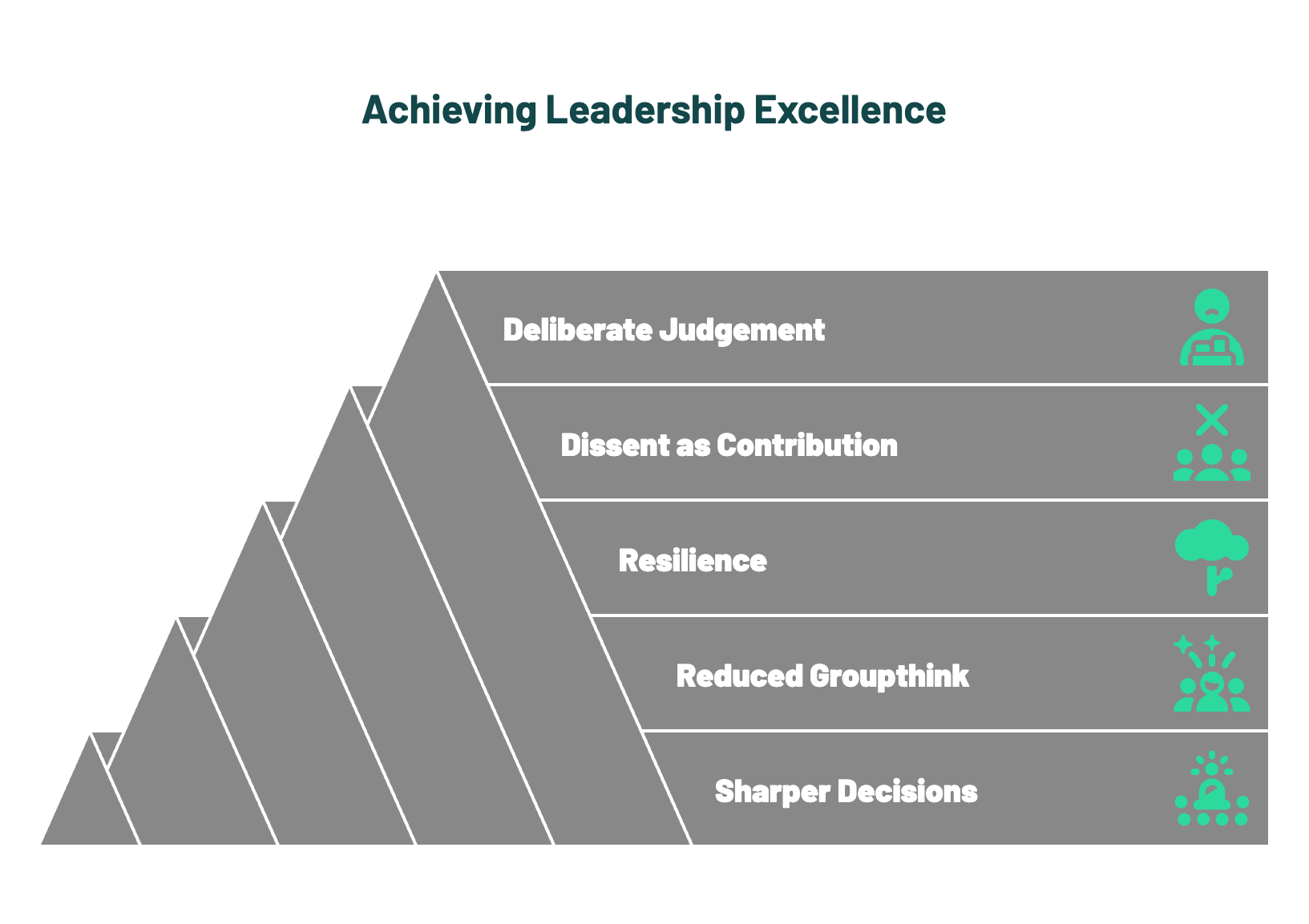Self Improvement
August 20, 2025
6
Min
Seven Daily Questions to Build Critical-Thinking Habits
Critical Thinking
|
Critical thinking is rarely a dramatic “aha” moment. It’s a daily discipline, built not in boardrooms but in the rhythms of how we notice, probe, and decide. Leaders who consistently sharpen this muscle make better calls under pressure, resist easy narratives, and see risks before they blindside the organisation.

A Harvard Business Review survey found that 81% of executives view critical thinking as the top competency for future leaders. Yet, paradoxically, fewer than one in three organisations offer training in it. In other words, most leaders are expected to show critical judgement, but left to self-train.
That gap can become a competitive edge. Leaders who institutionalise critical thinking habits in their own practice model them for teams. The result is an organisation less prone to groupthink, more agile in execution, and better prepared for the unexpected.

We’ve found that the simplest and most sustainable way to embed critical thinking is to make it a ritual. Seven questions, one for each day of the week, can become a rotation that gradually shapes how you see, decide, and lead.
Every project, pitch, or plan rests on a hidden assumption. Perhaps it’s that customer behaviour won’t change, or that costs will remain stable. Exposing one assumption each Monday keeps you alert to fragility in your decisions.
Critical thinking falters when the circle of voices is too narrow. On Tuesday, ask who hasn’t been consulted. Is it a frontline employee, a customer, a regulator, a sceptical peer?
Mid-week is when we’re most likely to double down on momentum, ignoring disconfirming data. Instead, set a condition: what would it take for me to reverse my current position?
By Thursday, fires are burning. The temptation is quick fixes. Critical thinking requires separating surface noise from root issues.
End of week reports often reinforce what is easy to track, not what matters. Ask yourself what isn’t being measured but should be.
Weekends offer mental distance. Imagine the sharpest critic of your strategy. What holes would they poke? Where would they laugh at your blind spots?
Sunday is for reflection. Scan the past week for moments where you went with the obvious, the routine, the comfortable.
Turning these questions into leadership practice requires more than good intentions. It means:
Pro Tip: Pair each question with a colleague who can hold you accountable. Shared inquiry keeps the practice alive.

When did I last reverse a decision because new evidence demanded it?
In the past month, which missing voices have meaningfully shifted my view?
Leaders who commit to this seven-question cycle often report:
And perhaps most importantly, they feel less caught in the noise of busyness and more anchored in deliberate judgement.

Choose one of the seven questions and practise it this week. Don’t wait to “roll out the full system”. Start small. Notice what shifts. Share your experience with peers or with us - we’re collecting stories of how leaders adapt these prompts in the real world.
Team SHIFT
What if the most powerful leadership tool you used today wasn’t a strategy deck or a financial model, but a question? And not a grand, sweeping question about the future of your industry, but a small, sharp one you asked yourself over morning coffee or in the few minutes between meetings.
Critical thinking is rarely a dramatic “aha” moment. It’s a daily discipline, built not in boardrooms but in the rhythms of how we notice, probe, and decide. Leaders who consistently sharpen this muscle make better calls under pressure, resist easy narratives, and see risks before they blindside the organisation.

A Harvard Business Review survey found that 81% of executives view critical thinking as the top competency for future leaders. Yet, paradoxically, fewer than one in three organisations offer training in it. In other words, most leaders are expected to show critical judgement, but left to self-train.
That gap can become a competitive edge. Leaders who institutionalise critical thinking habits in their own practice model them for teams. The result is an organisation less prone to groupthink, more agile in execution, and better prepared for the unexpected.

We’ve found that the simplest and most sustainable way to embed critical thinking is to make it a ritual. Seven questions, one for each day of the week, can become a rotation that gradually shapes how you see, decide, and lead.
Every project, pitch, or plan rests on a hidden assumption. Perhaps it’s that customer behaviour won’t change, or that costs will remain stable. Exposing one assumption each Monday keeps you alert to fragility in your decisions.
Critical thinking falters when the circle of voices is too narrow. On Tuesday, ask who hasn’t been consulted. Is it a frontline employee, a customer, a regulator, a sceptical peer?
Mid-week is when we’re most likely to double down on momentum, ignoring disconfirming data. Instead, set a condition: what would it take for me to reverse my current position?
By Thursday, fires are burning. The temptation is quick fixes. Critical thinking requires separating surface noise from root issues.
End of week reports often reinforce what is easy to track, not what matters. Ask yourself what isn’t being measured but should be.
Weekends offer mental distance. Imagine the sharpest critic of your strategy. What holes would they poke? Where would they laugh at your blind spots?
Sunday is for reflection. Scan the past week for moments where you went with the obvious, the routine, the comfortable.
Turning these questions into leadership practice requires more than good intentions. It means:
Pro Tip: Pair each question with a colleague who can hold you accountable. Shared inquiry keeps the practice alive.

When did I last reverse a decision because new evidence demanded it?
In the past month, which missing voices have meaningfully shifted my view?
Leaders who commit to this seven-question cycle often report:
And perhaps most importantly, they feel less caught in the noise of busyness and more anchored in deliberate judgement.

Choose one of the seven questions and practise it this week. Don’t wait to “roll out the full system”. Start small. Notice what shifts. Share your experience with peers or with us - we’re collecting stories of how leaders adapt these prompts in the real world.
Team SHIFT
What if the most powerful leadership tool you used today wasn’t a strategy deck or a financial model, but a question? And not a grand, sweeping question about the future of your industry, but a small, sharp one you asked yourself over morning coffee or in the few minutes between meetings.
Critical thinking is rarely a dramatic “aha” moment. It’s a daily discipline, built not in boardrooms but in the rhythms of how we notice, probe, and decide. Leaders who consistently sharpen this muscle make better calls under pressure, resist easy narratives, and see risks before they blindside the organisation.

A Harvard Business Review survey found that 81% of executives view critical thinking as the top competency for future leaders. Yet, paradoxically, fewer than one in three organisations offer training in it. In other words, most leaders are expected to show critical judgement, but left to self-train.
That gap can become a competitive edge. Leaders who institutionalise critical thinking habits in their own practice model them for teams. The result is an organisation less prone to groupthink, more agile in execution, and better prepared for the unexpected.

We’ve found that the simplest and most sustainable way to embed critical thinking is to make it a ritual. Seven questions, one for each day of the week, can become a rotation that gradually shapes how you see, decide, and lead.
Every project, pitch, or plan rests on a hidden assumption. Perhaps it’s that customer behaviour won’t change, or that costs will remain stable. Exposing one assumption each Monday keeps you alert to fragility in your decisions.
Critical thinking falters when the circle of voices is too narrow. On Tuesday, ask who hasn’t been consulted. Is it a frontline employee, a customer, a regulator, a sceptical peer?
Mid-week is when we’re most likely to double down on momentum, ignoring disconfirming data. Instead, set a condition: what would it take for me to reverse my current position?
By Thursday, fires are burning. The temptation is quick fixes. Critical thinking requires separating surface noise from root issues.
End of week reports often reinforce what is easy to track, not what matters. Ask yourself what isn’t being measured but should be.
Weekends offer mental distance. Imagine the sharpest critic of your strategy. What holes would they poke? Where would they laugh at your blind spots?
Sunday is for reflection. Scan the past week for moments where you went with the obvious, the routine, the comfortable.
Turning these questions into leadership practice requires more than good intentions. It means:
Pro Tip: Pair each question with a colleague who can hold you accountable. Shared inquiry keeps the practice alive.

When did I last reverse a decision because new evidence demanded it?
In the past month, which missing voices have meaningfully shifted my view?
Leaders who commit to this seven-question cycle often report:
And perhaps most importantly, they feel less caught in the noise of busyness and more anchored in deliberate judgement.

Choose one of the seven questions and practise it this week. Don’t wait to “roll out the full system”. Start small. Notice what shifts. Share your experience with peers or with us - we’re collecting stories of how leaders adapt these prompts in the real world.
Team SHIFT
